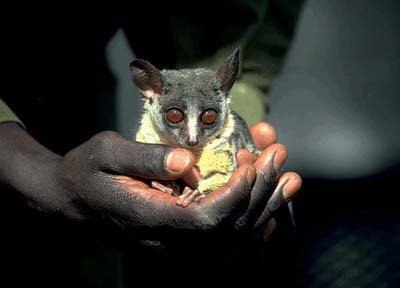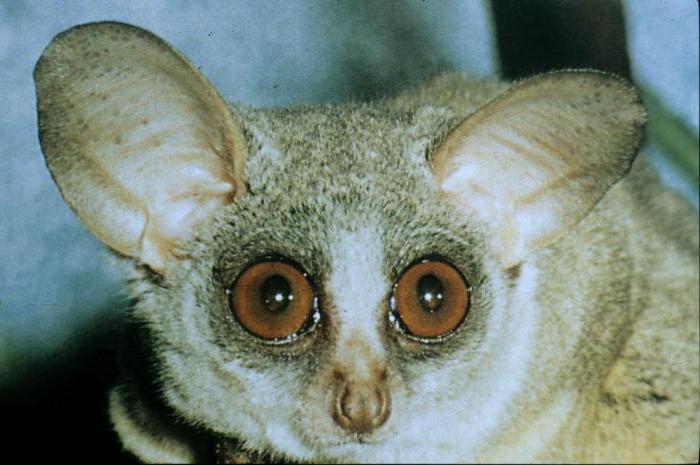Craving for wildlife makes the townspeople look for an outlet for themselves. Some prefer a summer cottage with a dozen or two chickens, others prefer a canary in a cage or a fish in an aquarium. The overwhelming majority of megalopolis residents prefer larger pets - a cat, a dog, or something unusual. Galago - an animal that, along with other "exotics", is gradually gaining popularity as a pet. Today, it is completely legal to purchase almost any individual from any continent of the Earth.
Description
Galago - an animal (see photo in the text), belonging to the class of primates. In total there are about 25 of its species. There are characteristic features inherent in all galago:
- Habitat. The African continent is their homeland, where they are ubiquitous.
- Appearance. Nice sharp muzzle with saucer eyes, almost transparent ears. Small forelegs with five fingers, in some species with rather long claws. Beautiful fluffy tail is slightly longer than the body. Color from gray to brown with an orange tint.
- Lifestyle. These are nocturnal creatures. In the afternoon they rest in the circle of their family, it can count from 2 to 7 individuals. Males live separately and communicate with females only during the mating period. They hunt alone. They can collect fruits on the ground, but they walk poorly, their limbs are more adapted for jumping.
- Galago - an animal strictly observing the boundaries of its possessions. Only females are allowed to enter the territory of the male. If an opponent appears, the owner first cries out about his rights to the territory. This is enough for the "men" to disperse peacefully. With very few exceptions, it comes to a fight.
- Reproduction. The frequency of mating in different species varies from two times a year to once every two years. Pregnancy lasts from 120 to 150 days. The female produces from one to three cubs. The first week they are completely helpless. In case of danger, the mother takes the children to a safe place like a kitten cat "by the scruff". Later, having gained a little strength, the cubs triple on the female’s back. This period lasts up to two months. The period of feeding with milk lasts as much, sometimes longer. By about four months old, the cubs can get their own food. Puberty occurs at 8-11 months. Life expectancy in different species from 6 to 18 years.
Classification
To date, three genera of these primates have been identified. Previously, zoologists had a different point of view. To one single genus Galago, scientists initially attributed all animals to the galago. Description, classification, habitat are given below:

- The genus echinoderms - Euoticus. A distinctive feature of representatives of this genus is the presence of long claws. With their help, they move through the trees. These include Euoticus elegantulus (elegant), has a protective status. Distributed in the tropical and subtropical forests of Equatorial Guinea, Gabon, Cameroon, Congo. Euoticus pallidus (light) is widespread in the humid tropical jungle throughout Central Africa.
- Genus galago (Galago). Among the numerous representatives of the genus there are the smallest ones: Galago demidoff (Demidova), whose body length does not exceed 16 cm. Their territory is the equatorial forests of West and Central Africa. They prefer to live on trees in nests, choose roadside zones, forest edges, clearings. Galago alleni (Allen) and Galago cameronensis (Cameroonian) share subtropical, tropical dry forests in Cameroon. Galago gabonensis (Gabonese), earlier it was attributed to Allen's galago, was later assigned to a separate group. It lives in the evergreen forests of Gabon, Congo and Cameroon. Galago gallarum (Somali) is distributed in the savannah forests of Somalia, Ethiopia, Kenya. Galago matschiei (eastern) inhabits the east of Africa: Congo, Rwanda, Uganda, Burundi. They prefer the lower tier of rainforests. Galago moholi (southern) - small animals of gray color with yellow marks on the stomach and paws. Their home is forest edges, acacia thickets, a shroud in the central part of South Africa. Galagoides nyasae (Malawian) lives in a limited area in the southern region of Malawia. Galago orinus (dwarf), his place of residence is the mountainous regions of Tanzania, while Galago rondoensis (Rodon) prefers a forest in the east of the country. Galago thomasi (Thomas) - surprisingly jumping primates inhabiting Central and Western equatorial Africa. Galago zanzibaricus (Zanzibar) lives on the wooded areas of the island of Zanzibar. He likes coastal zones, mountain and lowland forests. Galago senegalensis (Senegalese) lives on the equator line (in Senegal) in the shrubs of tropical rain forests.
- The genus of thick-tailed galago - Otolemur. The largest representatives of the Galaga are distributed in the eastern region of South Africa, Mozambique, Angola, Tanzania, Kenya, Zimbabwe. They prefer moist tropical, coastal, tugai and mountain forests. Representatives: Otolemur crassicaudatus (thick-tailed), Otolemur monteiri (silver), Otolemur garnettii (Garnett).
Of the variety for keeping at home, two species are preferable: Senegalese and thick-tailed, we will dwell on them a little more.
Senegalese Galago
Senegalese galago is a miniature animal, the length of its body does not exceed 17 cm. The tail is slightly longer than the body. Weight ranges from 180-220 grams, with males ten percent heavier than females. Description:
- The coat is thick and soft, ash gray. On the body it is short, on the tail the hair is longer, this adorns the animal, making it beautiful and fluffy.

- Of the senses, hearing, smell and sight are well developed. Huge eyes allow you to see well in the dark. Ears, like radar radars, can turn in any direction. When climbing trees or jumping between them, galagos stack them, protecting them from injuries.
- The animals jump smartly and well. The hind limbs are larger than the forelimbs and are able to push the body up to two meters in length. The tail is the balancer.
- Lead a nocturnal lifestyle. During the day they sleep in nests or hollows. Usually spend the night in company, with your family. Go hunting alone.
- The diet is diverse, primates are omnivorous. In adverse times, they can get along with tree branches, plants, acacia resin. They love juicy fruits, almost everything that grows in tropical forests. They enjoy bird eggs with pleasure, if they are lucky and chicks. Eat small insects.
- Can bring posterity twice a year. The duration of pregnancy is 120-150 days, from one to three babies in a litter. In natural conditions they live up to 8 years, in captivity, the term can be twice as long.
Thick-tailed galago
The thick-tailed galago is a rather large animal. Compared to Senegalese, it’s generally a giant. Its weight can reach two kilograms (in males). Body length 27-33 cm, tail length 37-43 cm. Despite their decent weight, thick-tailed animals jump great. The length of the jump can be 3 meters.
In terms of lifestyle, they practically do not differ from their brothers. A significant difference is the frequency of reproduction. Females of thick-tailed primates give birth no more than once every one and a half to two years. Have offspring within 120-130 days. Life expectancy in the wild is 14-18 years, in captivity, with the correct maintenance, it can reach 24 years.
Home Content
As a pet, a halo is easy to maintain. A nocturnal lifestyle helps him calmly survive a day's separation from his master. In the daytime, the animal sleeps in the house, curled up. His night vigil is almost silent, can only loudly snooze some delicious food.
Better kept in a cage, for its own safety. A smart kid can easily get injured in an apartment: get into a battery, get hit by a door and so on. An evening walk around the room under supervision will be enough. The room should be warm, it's still an African resident. No drafts are necessary.
The primate does not have a specific smell, is fairly tidy, and easily gets used to a person. He loves affection and attention, does not tolerate violence - it is difficult to forcibly hold on hands, he will break free and try to bite.
Cell
Animal galago at home requires a specially equipped cage. Size depends on the type of animal. A Senegalese baby will feel comfortable in a cage with a volume of at least 1.5 m 3 . A thick-tailed aviary will be required. The house is equipped with ropes, branches, crossbeams on which the animal can climb and jump. Be sure to have a house, it is better to move it outside the cell, so more useful area will be saved.
The floor is lined with sawdust, hay or straw. The more often you clean, the less unpleasant odors will be in the apartment. The toilet tray is unlikely to help, these primates are not accustomed to it.
Nutrition
Galago is an omnivorous animal; feeding it at home will not be difficult. A prerequisite is to combine animal and vegetable food. All fruits and vegetables will do. They are cut into pieces and left in a bowl. Nuts, low-fat chicken and beef meat, quail, boiled chicken eggs will be a great addition to the diet. Galago eats porridge cooked on water with pleasure.
The only inconvenience is that you need live food. In this capacity, daily chickens, newborn mice, cockroaches of a certain type can act.
Facts only
There are very interesting features of the galago:
- the animal peculiarly marks the territory, wetting the limbs in its own urine;
- large ears are able to fold into a horizontal tube - this ensures a quiet sleep during the day and the safety of the ears when moving between tree branches;
- urine is a means of caring for the ears, rubbing them with liquid, animals save thin skin from drying out;
- the galago has a second cartilaginous tongue;
- in Africa he is called the “bush baby,” for his cry that resembles a baby’s cry;
- about 20 different sounds are used for communication;
- chimpanzees hunt them, using a pointed stick, like a spear;
- the neck provides a head rotation of 180 degrees.